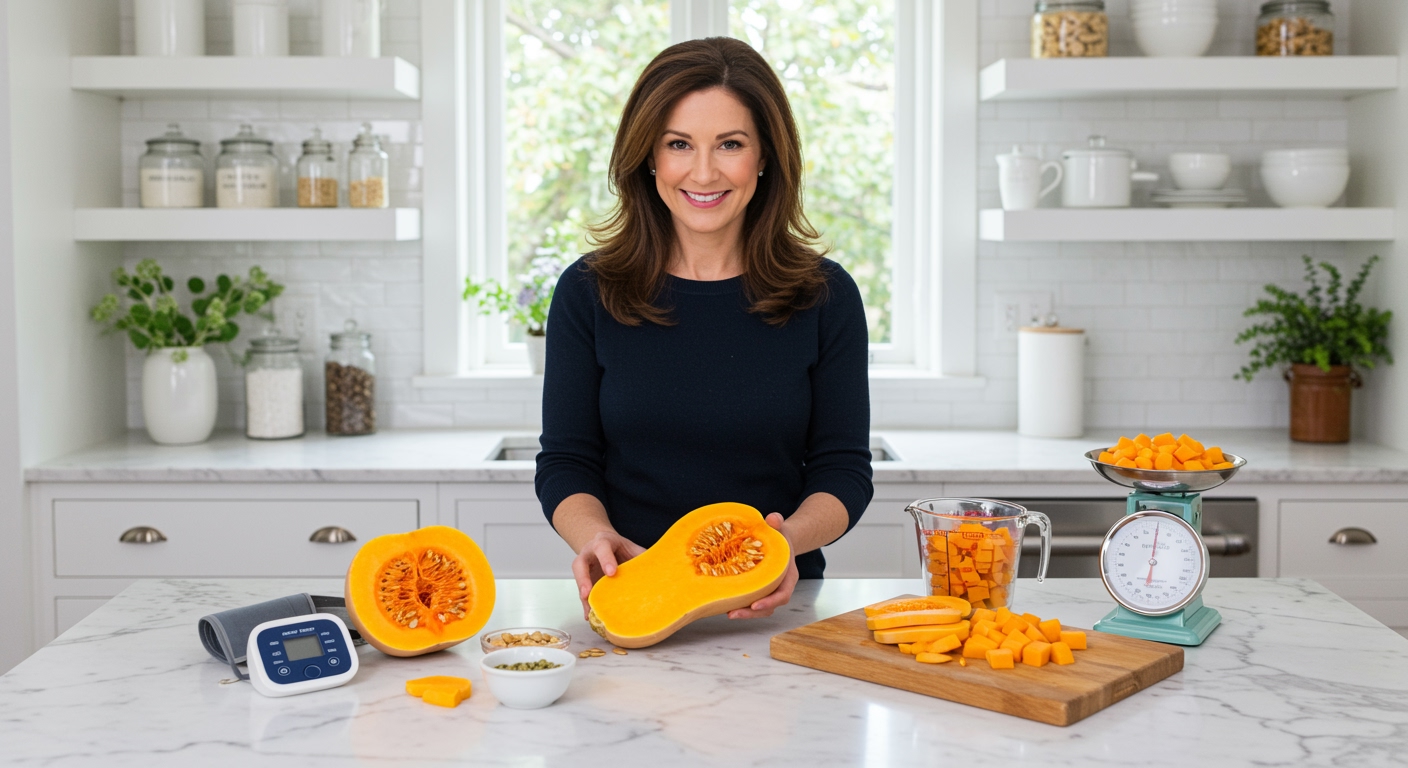✪ Key Takeaway: Butternuts can help manage blood pressure through high potassium content, fiber, and antioxidants that support cardiovascular health.
Introduction
Your doctor just told you to watch your blood pressure, and now you are staring at a grocery store full of confusing choices.
You might be wondering if that orange butternut squash in the produce section could actually help your numbers, especially when most people focus on expensive supplements or restrictive diets.
Hi, I am Abdur, your nutrition coach, and today I am going to explain how butternuts can become a powerful ally in your blood pressure management journey.
What Makes Butternuts Special For Blood Pressure?
Butternuts contain an impressive 582 milligrams of potassium per cup, which is more than many foods doctors typically recommend for blood pressure control.
This potassium content works by helping your kidneys remove excess sodium from your body through urine.
When sodium levels drop, your blood vessels can relax, and the pressure inside them naturally decreases.
The fiber content in butternuts also plays a crucial role by helping maintain healthy cholesterol levels and supporting overall cardiovascular function.
Research shows that people who eat more potassium-rich vegetables like butternuts have significantly lower blood pressure readings compared to those who avoid them.
The natural sugars in butternuts are balanced by fiber, which prevents blood sugar spikes that can stress your cardiovascular system.
✪ Fact: One cup of cooked butternut squash provides about 16% of your daily potassium needs.
How Much Should You Eat For Results?
Most nutrition experts recommend eating one to two cups of cooked butternut squash three to four times per week for optimal blood pressure benefits.
This amount provides approximately 1,200 to 2,400 milligrams of potassium weekly, which can make a measurable difference in your blood pressure readings.
You can spread this intake throughout the week by adding half a cup to your lunch and dinner on alternating days.
The key is consistency rather than eating large amounts occasionally, because your body processes potassium continuously throughout the day.
Start with smaller portions if you are not used to eating high-fiber foods, as your digestive system needs time to adjust.
People taking blood pressure medications should consult their doctor before significantly increasing their potassium intake, as some medications can affect how your body handles this mineral.
✪ Pro Tip: Roast butternut cubes with olive oil and herbs for maximum nutrient absorption.
What Other Nutrients Support Blood Pressure?
Beyond potassium, butternuts contain magnesium, which helps relax blood vessel walls and supports healthy blood flow.
The beta-carotene in butternuts converts to vitamin A in your body, which supports the health of your blood vessel linings.
This orange vegetable also provides vitamin C, an antioxidant that protects your blood vessels from damage caused by free radicals.
The natural folate content helps your body produce healthy red blood cells and supports proper circulation.
These nutrients work together in what scientists call a synergistic effect, meaning they are more powerful when consumed together than individually.
The fiber in butternuts also feeds beneficial gut bacteria, which produce compounds that can help regulate blood pressure through the gut-heart connection.
✪ Note: Cooking butternuts actually increases the bioavailability of their beta-carotene content.
Are There Any Risks Or Side Effects?
Most people can safely eat butternuts without any negative effects, but there are a few important considerations to keep in mind.
People with kidney disease should limit their potassium intake, as damaged kidneys cannot properly remove excess potassium from the blood.
If you take ACE inhibitors or potassium-sparing diuretics for blood pressure, eating large amounts of high-potassium foods might cause hyperkalemia.
This condition occurs when potassium levels become too high, which can affect your heart rhythm and require immediate medical attention.
Some people experience digestive discomfort when they suddenly increase their fiber intake, so start slowly and drink plenty of water.
The natural sugars in butternuts are generally well-tolerated, but people with diabetes should monitor their blood sugar levels when adding new foods to their diet.
✪ Pro Tip: Always discuss significant dietary changes with your healthcare provider if you take blood pressure medications.
What Are The Best Ways To Prepare Butternuts?
Roasting is one of the most effective preparation methods because it concentrates the flavors while preserving most of the nutrients.
Cut the butternut into cubes, toss with a small amount of olive oil, and roast at 400 degrees Fahrenheit for about 25 minutes.
Steaming preserves the maximum amount of water-soluble vitamins and minerals, making it ideal for people focused on blood pressure benefits.
You can also add butternut to soups and stews, where it absorbs flavors while contributing its own nutritional value to the dish.
Avoid adding excessive salt during cooking, as this counteracts the blood pressure benefits you are trying to achieve.
Instead, use herbs like rosemary, thyme, or sage to enhance flavor while supporting your cardiovascular health goals.
✪ Fact: Butternut squash can be stored for up to six months in a cool, dry place.
The Bottom Line
Butternuts can definitely help manage blood pressure through their impressive potassium content, fiber, and supporting nutrients that work together to support cardiovascular health.
Real nutrition happens when you choose whole foods that your body recognizes and can use effectively, and butternuts perfectly fit this philosophy.
I would love to hear about your experience with butternuts or any questions you might have about incorporating them into your blood pressure management plan, so please share your thoughts in the comments below.
References
At NutritionCrown, we use quality and credible sources to ensure our content is accurate and trustworthy. Below are the sources referenced in creating this article:
- PubMed: Dietary potassium and blood pressure regulation
- Health Digest: Butternut Squash Nutrition Lower Blood Pressure Sugar Same Time
- Silva International: Understanding the Health Benefits of Butternut Squash
- Harvard DASH: DASH Diet Research





